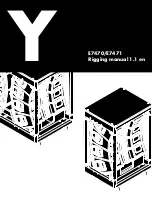
8
OPERATIONAL INSTRUCTION OVERVIEW
Operation
– Both manual and electrically powered winches develop tremendous forces; therefore,
all backstops must be operated by qualified personnel only to avoid structural damage or possible
personal injury. Authorized personnel is defined as an individual (or individuals) who is at least 21
years of age, has been trained for the proper operation of the unit, and is sanctioned by the facility
as being responsible for the operation of the equipment.
Should your backstop be a stationary model (non-folding), supervision of its’ use is still required.
Wall mounted units must have all components attached securely. This includes all chain supports,
cross flats, extension pipes, etc. Should your backstop be altered in any way from the “as-built”
drawing(s), contact Porter immediately, and
DO NOT USE
the equipment.
Improperly installed
or altered wall mounted backstops have the potential to cause serious personal injury, or
even death.
Electrically Operated Equipment
– The wall mounted key switch must be flush-mounted on the
wall and located in full view of the gymnasium equipment so that the operator may stop the opera-
tion of the equipment should there be any malfunction during the raising and lowering cycles. At
no time should the key switch or reversing switch on the portable electric operator be reversed
quickly, as this may cause damage to gears and may cause the electrical circuitry to override the
up-and-down limits. On the up cycle, the backstop operation must halt before any portion of it
strikes the building structure.
Manually Operated Equipment
– Limit switches or mechanical stops may not be used. There-
fore, it is the responsibility of the operator to stop the hoisting operation before the backstop strikes
an obstruction. As a visual aid, a piece of tape may be placed on the hoist cable to align with the
top of winch when the backstop is in the up position.
Important Note
– These units can be dangerous if operated carelessly by inexperienced person-
nel; therefore, the keys or handles of the manual winches must be in the possession of responsi-
ble, trained personnel only. Proper operation and maintenance will promote longevity to the equip-
ment and avoid the possibility of accidents.
MAINTENANCE CHECKLIST
This inspection checklist is to assist you with your maintenance program. As you are making the
inspection, enter an “S” for satisfactory, or an “R” for repair or replacement.
Porter recommends a maintenance inspection take place at least once a year by a Porter Certified
Inspector, using the attached check list. Porter recommends the same check list be used as a
guide for additional inspections by facility personnel or operators every 6 months. Any abnormal
movement or sound during operation is cause for an immediate and thorough inspection. The an-
nual inspection by a Porter Certified Inspector is required to maintain the extended limited warran-
ty.
1.
Wall Anchors
– Inspect all anchors to ensure they are tight. Check all wood pads for splits;
replace as necessary. Be certain all wood pads tight to the wall; sight from each edge of the
pad to ensure there is no gap between the wall and wood pad. Inspect wall for cracks, which
may indicate a support problem.
2.
Chain Supports
– Carefully examine the entire chain support. Make certain no turned eyes,
“S” hooks, etc. were substituted (refer to “General Hardware Guidelines”). Replace with appro-
priate hardware, as indicated. The chain support at the wall (or overhead support) must be se-
curely anchored as noted in this manual. Chain to be secured to upper structure by a repair
link, threaded “Quick” link, or minimum Grade 5 bolt only. The clamp securing the chain at the
extension pipe must be either backed be a second clamp, or secured with a rivet through the
wall of the pipe. Inspect the chain for any fatigues links. Replace entire chain if any link is sus-
pect.
Summary of Contents for 219 Series
Page 49: ...INSTALLER NOTES...









































